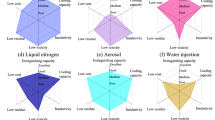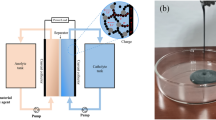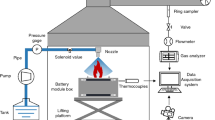Abstract
Accidents involving lithium-ion batteries in electric vehicles frequently occur, which limits the industry's growth and makes it more challenging to build the energy supply sustainably. In this study, we add a liquid-phase input end to make cup burner suitable for the fire-extinguishing test of liquid-phase fire-extinguishing agent and test the minimum extinguishing concentration (MEC) of C6F12O on the synthesis gas of lithium-ion battery. Furthermore, the physical effects and chemical effects of C6F12O on lithium-ion battery syngas fire are quantified by the perfect stirred reactor (PSR) model. The result shows that the fire-extinguishing effect of C6F12O on lithium-ion battery fire mainly depends on the physical effect of cooling.







Similar content being viewed by others

References
Feng X, Ren D, He X, et al. Mitigating thermal runaway of lithium-ion batteries. J Joule. 2020;4(4):743–70.
Chen W, Yan J, Meng L, et al. Research progress on fire hazards of lithium batteries for electric vehicles. J Power Technol. 2021;45(2):270–3.
Wang S, Zhiming Du, Han Z, Zhang ZeLin, Liu L, Hao JinYuan. Study of the Temperature and flame characteristics of two capacity LiFePO4 batteries in thermal runaway. J Electrochem Soc J. 2018;165(16):A3828–36.
Beijing institute of technology. lithium-ion battery thermal runaway explosion safety prevention and control method and device: CN202010141141.0[P]. 2020–07–17.
Sun Q, Liu H, Zhi M, et al. Thermal characteristics of thermal runaway for pouch lithium-ion battery with different state of charges under various ambient pressures. J J Power Sour. 2022;527:231175.
Deng K, Zhang Y, Bole Xu, et al. Research on the combustion characteristics of lithium iron phosphate batteries. J Chin Saf Sci J. 2019;29(11):83–8.
Ping P, Wang Q, et al. Study of the fire behavior of high-energy lithium-ion batteries with full-scale burning test. J J Power Sour. 2015;285:80–9.
Yang X, Duan Y, Feng X, et al. An Experimental study on preventing thermal runaway propagation in lithium-ion battery module using aerogel and liquid cooling plate together. J Fire Technol. 2020. https://doi.org/10.1007/s10694-020-00995-x.
Li Yanyan. Novec 1230 fire extinguishing agent. J Fire Sci Technol. 2013;4:120.
Surhone LM, Timpledon MT, Marseken SF, et al. Novec 1230. J Landolt Brnstn Group IV Phys Chem. 2010;26(1976):263–91.
Yuan W, Bai H. Study on the compatibility of a new type of high boiling point fire extinguishing agent and elastic sealing materials. J China Saf Prod Sci Technol. 2021;17(7):10–5.
Chen P, Zhuang S, Liu Qi, et al. Research on the production of hydrogen fluoride by thermal cracking of C6F12O fire extinguishing agent. J Fire Sci Technol. 2020;39(9):1277–9.
Liu Y, et al. Experimental study on the efficiency of dodecafluoro-2-methylpentan-3-one on suppressing lithium-ion battery fires. J RSC Adv. 2018;8(73):42223–32.
Chombo PV, Laoonual Y. A review of safety strategies of Li-ion battery. J J Power Sour. 2020;478:228649.
Liu Yujun, et al. Experimental study on a novel safety strategy of lithium-ion battery integrating fire suppression and rapid cooling. J J Energy Storage. 2020;28:101185–101185.
Hirst R, Booth K. Measurement of flame-extinguishing concentrations. J Fire Technol. 1977;13(4):296–315.
Chen T, Dayong Lu, Cheng Hu, et al. Research on the critical extinguishing concentration test of C6F12O fire extinguishing agent. J Fire Sci Technol. 2015;34:86–90.
Chen Tao, Xuecheng Fu, Zhou Xiaomeng. Fire extinguishing performance of fluorinated ketone fire extinguishing agent. J Combust Sci Technol. 2016;22(114):75–80.
Zhao J, Yin Z, Shahid MU, Xing H, Cheng X, Fu Y, Lu S. Superhydrophobic and oleophobic ultra-fine dry chemical agent with higher chemical activity and longer fire-protection. J Hazard Mater. 2019;15(380):120625.
Qin P, Jia Z, Jin K, et al. The experimental study on a novel integrated system with thermal management and rapid cooling for battery pack based on C6F12O spray cooling in a closed-loop. J J Power Sour. 2021;516:230659.
Liu Y, Duan Q, Jiajia Xu, et al. Experimental study on the efficiency of dodecafluoro-2-methylpentan-3-one on suppressing lithium-ion battery fires. J RSC Adv. 2018;8:42223–32.
Liu Y, Yang K, Zhang M, et al. The efficiency and toxicity of dodecafluoro-2-methylpentan-3-one in suppressing lithium-ion battery fire. J J Energy Chem. 2022;65:532–40.
Zhang L, Li Y, Duan Q, et al. Experimental study on the synergistic effect of gas extinguishing agents and water mist on suppressing lithium-ion battery fires. J J Energy Storage. 2020;32:101801.
F Hashi, VR Katta, VI Babushok, et al. Numerical and experimental studies of extinguishment of cup-burner flames by C6F12O, J. Proceedings of the Combustion Institute. 2020.
Jianke Du. Research progress of the cup-burner method fire-extinguishing concentration test technology[C]. China Fire Protection Association Science and Technology Annual Conference Proceedings. 2013; 321–323.
Xiaomin Ni, Kaiqian Kuang, Mei Zhao, et al. Experimental study on suppression of extinguishing methane/air flame of cup-burner with bromotrifluoropropene. J. 2013.
Informatik HC. An introduction to combustion: concepts and applications [M]. WCB/McGraw-Hill. 2000.
Zhang Z, Zhiming Du, Han Z, Wang H, Wang S. Temperature characteristics of lithium iron phosphatepower batteries under overcharge. Int J Energy Res. 2020;44(14):11840–51.
Babushok VI, Linteris GT, Burgess DR Jr, Baker PT. Hydrocarbon flame inhibition by C3H2F3Br (2-BTP). Combust Flame. 2015;162(4):1104–12.
Turns Stephen R. Introduction to combustion: concepts and applications [M]. Tsinghua University Press. 2015.
Roberts AF, Wuince BW. A limiting condition for the burning of flammable liquids. J Combust Flame. 1973;20(2):245–51.
Liu L, Zhiming Du, Zhang T, et al. The inhibition/promotion effect of C6F12O added to a lithium-ion cell syngas premixed flame. J Int J Hydro energy. 2019;44(16):22280–300.
Acknowledgements
This work was supported by National Natural Science Foundation of China No.22178026, and Science and Technology on Applied Physical Chemistry Laboratory, China, No. WDYX21614260202.
Author information
Authors and Affiliations
Corresponding author
Additional information
Publisher's Note
Springer Nature remains neutral with regard to jurisdictional claims in published maps and institutional affiliations.
Rights and permissions
Springer Nature or its licensor (e.g. a society or other partner) holds exclusive rights to this article under a publishing agreement with the author(s) or other rightsholder(s); author self-archiving of the accepted manuscript version of this article is solely governed by the terms of such publishing agreement and applicable law.
About this article
Cite this article
Han, Z., Zi, R., Yu, Y. et al. Study on the minimum extinguishing concentration of C6F12O for extinguishing synthesis gas flame of lithium-ion battery. J Therm Anal Calorim 148, 3631–3643 (2023). https://doi.org/10.1007/s10973-022-11934-z
Received:
Accepted:
Published:
Issue Date:
DOI: https://doi.org/10.1007/s10973-022-11934-z



